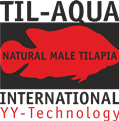A change of anti oxidants
from E321 and E324 to E310 and E320 in fish feed caused feminization in tilapia, a lowered resistance of fry, increased numbers of intersex individuals and degeneration of gonads. The use of RAS (Recirculation Aquaculture Systems) worsened these symptoms by accumulation of these additives.
Introduction
Til-Aqua International BV is a genetics company, for more than 25 years specialized in the production of YY-males that can give all-male Natural Male Tilapia (NMT) offspring for ongrowing without the use of hormones. During the past years the genetic selection program on the YY broodstock resulted in a male ratio of 99.7% in the NMT offspring.
However, in the first half of 2019 fluctuating male ratio results were found in the NMT, both in the Red and Silver strain; meaning increased numbers of females were found. Internal procedures were checked, but no mistakes could be identified in the selection and breeding program.
Sex ratio in tilapia can be affected by external parameters. After thoroughly examining possible external factors, there was only one that changed when the problems started at the end of 2018: the feed.
The feed company had made a change in its feed and this finding resulted in a vast comparative feed investigation. The investigation was very time-consuming and lasted from July 2019 until May 2020 as it takes time to produce a sufficient amount of test groups and repeat the tests several times.
Practical research and results
Offspring of different genetic lines were tested with several feeds from the same feed company in the first (susceptible) weeks of their life. Thousands of fingerlings were dissected and their gonads were examined macroscopically and microscopically – a procedure well known at Til-Aqua International. The following observations were made with all the used feeds:
- High and variable numbers of females up to 92% from broodstock that initially produced < 1%
- Large numbers of ‘intersex’ individuals ; individuals that contain gonads or gonadal tissue of both sexes.
- Disrupted gonadal development; when examining mature fish, deteriorated gonads were found.
- Lowered resistance of the fry, leading to more health issues and mortality.
- With very high refreshment rates, just like in a “flow-through” system, higher male ratios were found again – up to the common 99%. The negative effects of the feeds are mitigated; the higher the system’s water refreshment, the higher the male ratio and the stronger the fish.
Feed labels and literature
When comparing the feed labels of the ‘old’ feeds (used before the end of 2018) and the ‘new’ feeds (used after the end of 2018), a change in anti oxidants was found for all the feeds:
Old label:
E324 Ethoxyquine 100 mg/kg (nowadays forbidden to use)
E321 Butylhydroxytoluene 15 mg/kg
New label:
E310 Propylgallate 100 mg/kg (max allowed dose = 100 mg/kg)
E320 Butylhydroxyanisole 100 mg/kg (max allowed dose = 150 mg/kg)
After this observation an extensive literature study was started with irrefutable findings.
E310 – Propylgallate is considered to be an endocrine (hormone) disruptor of estrogen; in some cases it has shown to increase estrogenic effect while in others it acted opposite.
E320 – Butylatedhydroxyanisol (BHA) is considered as a weak estrogen that f.i. easily “feminizes” larval frogs (Xenopus leavis – which is a reference species for endocrine disruptors) in low concentrations 1). Another study showed that BHA had a severe effect on gonadal morphology of climbing perch (Anabas testudineus) males: a deterioration of the testis 2). These effects are in line with the observations in the executed offspring testing in the tilapia. The literature also referred to the European Union classifying E320 as Category 1; a substance with “clear evidence for endocrine disrupting effects in an intact organism” 3).
Conclusions
The feeds that contain the high levels of anti oxidants E310 and E320 (as described for the ‘new’ feeds), are not suitable for tilapia farming because of their undesirable estrogenic effect. Especially not in recirculation aquaculture systems (RAS) which are common in present aquaculture. In these systems the anti oxidants accumulate; increasing the negative effects. The earlier mentioned European Union document confirms this as “BHA (E320) is not readily biodegradable and has a high potential to bioaccumulate in the environment” 3).
Warning and advice
The effect on other fish species was not tested in the Til-Aqua International practical research. Nonetheless the degeneration of gonads and the related negative effect on the fertility by E320 is also mentioned in other fish species2). Therefore beware of the specific anti oxidants and their levels in fish feed by checking the labels or contacting your supplier! Based upon these findings, Til-Aqua International has decided to change feed supplier and uses now feeds that only contain E321 as an anti oxidant – which was found to be safe in the past. On this moment Til-Aqua International is back on track again.
Some of the literature that was consulted and supported our findings:
1) Amphibians as a model to study endocrine disruptors: II. Estrogenic activity of environmental chemicals in vitro and in vivo. (Link)
2) Fish short-term reproductive assay for evaluating the estrogenic property of a commonly used antioxidant, butylated hydroxyanisole. (Link)
3) Community Strategy for Endocrine Disruptors – a range of substances suspected of interfering with the hormone systems of humans and wildlife. (Link – page 2 and page 8)
